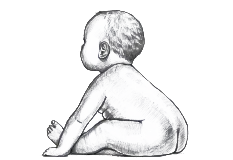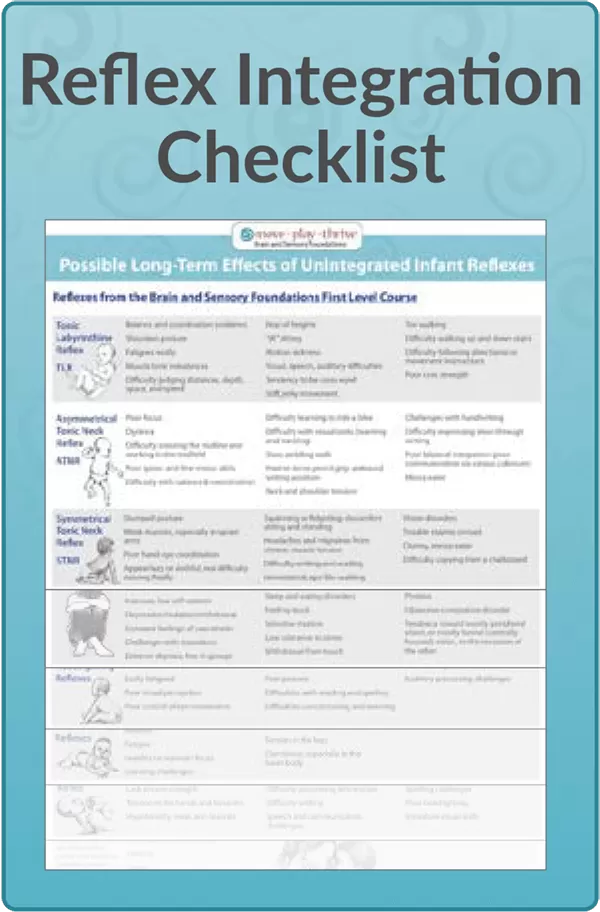Headrighting Reflexes
 Headrighting reflexes belong to the postural—rather than primitive—class of reflexes. Once developed, these reflexes are designed to be active and functioning throughout our lives. They support stamina, visual processing, and efficient recovery from head, neck, and back injuries.
Headrighting reflexes belong to the postural—rather than primitive—class of reflexes. Once developed, these reflexes are designed to be active and functioning throughout our lives. They support stamina, visual processing, and efficient recovery from head, neck, and back injuries.
The Headrighting reflexes are a set of reactions for keeping the head, and therefore the eyes, perpendicular to the ground when the body moves. To accomplish this, the head moves in the opposite direction of the body’s tilt. For example, when an individual leans to the left, the head should automatically go slightly to the right to maintain midline position. If the individual tilts forward, the head should move back, and so forth.
The Headrighting reflexes are meant to emerge around the 3rd or 4th month in utero. There are two types of Headrighting reflexes:
- Oculo-Headrighting: response to visual cues
- Labyrinthine Headrighting: response to changes in the inner ear, i.e. vestibular input
Both of these reflexes help to develop proper balance, coordination, and visual perception. In individuals with autism, the Headrighting reflexes are often underdeveloped. Developing the Headrighting reflexes can help increase stamina and recovery from head, neck, and back injuries.
When Headrighting is underdeveloped or absent, the visual field is unstable, putting stress on the body. Because the 44 pairs of neck muscles designed to hold up the head do not have their proper foundation, these muscles may be weak and unable to support the head well, resulting in a head that feels heavy. Individuals can also experience excessive tension in the neck and shoulders—unconscious tightening in an attempt to keep the head upright. More energy goes into compensations and “getting through the day”, resulting in less energy being available for cognitive function, exploration of the environment, and learning. Individuals can lack Headrighting in a single direction (i.e. when the torso is tilted forward), multiple directions (i.e. forward and back, or back and left etc.), or all directions.
Possible Long-Term Effects of an Underdeveloped Headrighting:
- Balance issues
- Poor posture
- Weak neck muscles
- Easily fatigued
- Poor visual perception
- Oculo-motor challenges
- Difficulty reading and spelling
- Concentration issues
- Amphibian Reflex
- Asymmetrical Tonic Neck Reflex
- Birth and Bonding
- Crawling Reflexes
- Crossed Extensor Reflex
- Facial-Oral Reflexes
- Fear Paralysis Reflex
- Feet Reflexes—Plantar & Babkinski
- Foot Tendon Guard
- Hand Reflexes—Grasp, Palmar, and Babkin
- Headrighting Reflexes
- Infant Torticollis
- Landau Reflex
- Moro Reflex
- Parachute Reflex
- Pull-to-Sit Reflex
- Spinal Galant Reflex
- Spinal Perez Reflex
- Symmetrical Tonic Neck Reflex
- Tonic Labyrinthine Reflex
Sources
Adamović, T., Jurišić-Škevin, A., Madić, D., Sovilj, M., Jeličić, L., Maksimović, S., & Subotić, M. (2022). Head righting reflex in newborns as the predictive factor of early child development: A longitudinal study. Early Child Development and Care, 192(5), 748-760.
Blomberg, H. (2015). The rhythmic movement method: A revolutionary approach to improved health and well-being. Lulu.com.
Bly, L. (2011). Components of typical and atypical motor development. Neuro-Developmental Treatment Association, Incorporated.
Bradshaw, J., Shi, D., Federico, A., Klaiman, C., & Saulnier, C. (2023). The Pull-to-Sit task: Examining infant postural development in autism spectrum disorder. The Journal of Pediatrics, 253, 225-231.
Flanagan, J., Landa, R., Bhat, A., & Bauman, M. (2012). Head lag in infants at risk for autism: A preliminary study. American Journal of Occupational Therapy, 66(5), 577-585.
Goddard Blythe, S. (2023). Reflexes, movement, learning & behavior. Analysing and unblocking neuro-motor immaturity. Hawthorn Press.
Masgutova, S. (2007). Integration of infant dynamic and postural reflex patterns: Neuro-sensory-motor and reflex integration method [Training manual].


